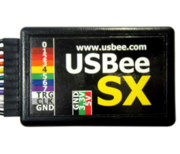Difference between revisions of "CWAV USBee SX"
Jump to navigation
Jump to search
Uwe Hermann (talk | contribs) m |
Uwe Hermann (talk | contribs) m |
||
| Line 16: | Line 16: | ||
The '''USBee SX''' is a USB-based, 8-channel logic analyzer (and signal generator) with up to 24MHz sampling rate. | The '''USBee SX''' is a USB-based, 8-channel logic analyzer (and signal generator) with up to 24MHz sampling rate. | ||
In sigrok, we use the open-source [[fx2lafw]] firmware for this logic analyzer. | |||
See [[CWAV USBee SX/Info]] for more detailed information on the device. | See [[CWAV USBee SX/Info]] for more detailed information on the device. | ||
| Line 22: | Line 22: | ||
== Hardware == | == Hardware == | ||
* Main chip: Cypress CY7C68013A-56PVXC (FX2LP) | * '''Main chip''': Cypress CY7C68013A-56PVXC (FX2LP) | ||
** '''Note:''' Older versions used the Cypress CY7C68013-56PVC (FX2), which is different in some ways (e.g. less SRAM) | ** '''Note:''' Older versions used the Cypress CY7C68013-56PVC (FX2), which is different in some ways (e.g. less SRAM) | ||
* 3.3V voltage regulator: ST LD33 | * '''3.3V voltage regulator''': ST LD33 | ||
* I2C EEPROM: Microchip 24LC01B | * '''I2C EEPROM''': Microchip 24LC01B | ||
* Crystal: 24MHz | * '''Crystal''': 24MHz | ||
== Photos == | == Photos == | ||
| Line 36: | Line 36: | ||
File:Usbee sx case back.jpg|<small>Device, back</small> | File:Usbee sx case back.jpg|<small>Device, back</small> | ||
File:Usbee sx case open.jpg|<small>Device, open</small> | File:Usbee sx case open.jpg|<small>Device, open</small> | ||
File:Usbee sx pcb front.jpg|<small>PCB ,front</small> | File:Usbee sx pcb front.jpg|<small>PCB, front</small> | ||
File:Usbee sx pcb back.jpg|<small>PCB, back</small> | File:Usbee sx pcb back.jpg|<small>PCB, back</small> | ||
</gallery> | </gallery> | ||
| Line 45: | Line 45: | ||
File:Cwav_usbee_sx_device_top.jpg|<small>Device, front</small> | File:Cwav_usbee_sx_device_top.jpg|<small>Device, front</small> | ||
File:Cwav_usbee_sx_device_bottom.jpg|<small>Device, back</small> | File:Cwav_usbee_sx_device_bottom.jpg|<small>Device, back</small> | ||
File:Cwav_usbee_sx_pcb_top.jpg|<small>PCB ,front</small> | File:Cwav_usbee_sx_pcb_top.jpg|<small>PCB, front</small> | ||
File:Cwav_usbee_sx_pcb_bottom.jpg|<small>PCB, back</small> | File:Cwav_usbee_sx_pcb_bottom.jpg|<small>PCB, back</small> | ||
File:Cwav_usbee_sx_revision_zx.jpg|<small>"USBee ZX" marking</small> | File:Cwav_usbee_sx_revision_zx.jpg|<small>"USBee ZX" marking</small> | ||
| Line 58: | Line 58: | ||
== Resources == | == Resources == | ||
* [http://usbee.com/software/ZXHelpFiles.zip USBee SX help files] | |||
* [http://usbee.com/usbeesuitemanual.pdf USBee Suite manual] | |||
* [http://usbee.com/usbeesuitesw.zip Vendor software] | |||
* [https://blog.visucore.com/2010/5/23/jtag-using-cypress-fx2-usb Visucore Blog: JTAG using USBee SX] | * [https://blog.visucore.com/2010/5/23/jtag-using-cypress-fx2-usb Visucore Blog: JTAG using USBee SX] | ||
* [https://blog.visucore.com/2010/5/28/pwm-on-the-usbee-hardware-using-custom-firmware Visucore Blog: PWM on the USBee with custom firmware] | * [https://blog.visucore.com/2010/5/28/pwm-on-the-usbee-hardware-using-custom-firmware Visucore Blog: PWM on the USBee with custom firmware] | ||
Revision as of 21:54, 16 December 2012
 | |
| Status | supported |
|---|---|
| Source code | fx2lafw |
| Channels | 8 |
| Samplerate | 24MHz |
| Samplerate (state) | — |
| Triggers | none (SW-only) |
| Min/max voltage | ? |
| Memory | none |
| Compression | none |
| Website | usbee.com |
The USBee SX is a USB-based, 8-channel logic analyzer (and signal generator) with up to 24MHz sampling rate.
In sigrok, we use the open-source fx2lafw firmware for this logic analyzer.
See CWAV USBee SX/Info for more detailed information on the device.
Hardware
- Main chip: Cypress CY7C68013A-56PVXC (FX2LP)
- Note: Older versions used the Cypress CY7C68013-56PVC (FX2), which is different in some ways (e.g. less SRAM)
- 3.3V voltage regulator: ST LD33
- I2C EEPROM: Microchip 24LC01B
- Crystal: 24MHz
Photos
New version with Cypress CY7C68013A (FX2LP):
Old version with Cypress CY7C68013 (FX2):
Protocol
Since we use the open-source fx2lafw firmware for this device, we don't need to know the protocol.
However, for those interested in this, someone else has already decoded most of it.









